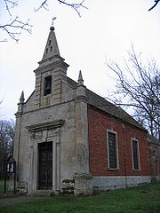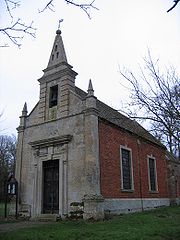
Little Gidding, Cambridgeshire
Encyclopedia
Little Gidding is a parish and small village
in Huntingdonshire
(now part of Cambridgeshire
), England
, near Sawtry
and north west of Huntingdon
.

the only entry was merely Geddinge, indicating that the parishes of Great Gidding
and Steeple Gidding were probably only separated later. Gidding, then owned by William Engaine, passed to his grandson, who gave Little Gidding to his younger son, Warner Engaine, in around 1166. At that time the manor was known as Gidding Warner, later becoming Gidding Engaine and by the 13th century Gydding Parva or Little Gidding.
In 1620 the then owner the Earl of March
sold the manor to Thomas Sheppard, who in turn sold it to Nicholas Ferrar
and Arthur Woodnoth in 1625 as trustees for Ferrar's mother, Mary Ferrar. Mary Ferrar repaired the manor house and church and on her death in 1634 left the manor to her son Nicholas.
The present church of St John the Evangelist was built in 1714 to replace a much earlier church on the site.
The name Gidding means "settlement of the family or followers of a man called Gydda".
. The Ferrar household lived a Christian life according to High Church
principles and the Book of Common Prayer
. The fame of the household was widespread, and they attracted visitors. King Charles I
visited Little Gidding three times, including on 2 May 1646 seeking refuge after the Battle of Naseby
. The religious community ended with the death of John Ferrar in 1657.
The community is memorably depicted in Joseph Shorthouse's 1881 novel John Inglesant.
to write the poem from the Four Quartets
of the same name
, completed in 1942. Eliot visited St John's Church in 1936. In the poem he refers to the "broken king" Charles and relates the struggles of the English civil war to the events of the Blitz
in World War II
.
An annual T. S. Eliot Festival is organised by the Friends of Little Gidding and the T. S. Eliot Society.
Village
A village is a clustered human settlement or community, larger than a hamlet with the population ranging from a few hundred to a few thousand , Though often located in rural areas, the term urban village is also applied to certain urban neighbourhoods, such as the West Village in Manhattan, New...
in Huntingdonshire
Huntingdonshire
Huntingdonshire is a local government district of Cambridgeshire, covering the area around Huntingdon. Traditionally it is a county in its own right...
(now part of Cambridgeshire
Cambridgeshire
Cambridgeshire is a county in England, bordering Lincolnshire to the north, Norfolk to the northeast, Suffolk to the east, Essex and Hertfordshire to the south, and Bedfordshire and Northamptonshire to the west...
), England
England
England is a country that is part of the United Kingdom. It shares land borders with Scotland to the north and Wales to the west; the Irish Sea is to the north west, the Celtic Sea to the south west, with the North Sea to the east and the English Channel to the south separating it from continental...
, near Sawtry
Sawtry
Sawtry is a village in the district of Huntingdonshire in the county of Cambridgeshire, England. The village is home to over people.-Location:...
and north west of Huntingdon
Huntingdon
Huntingdon is a market town in Cambridgeshire, England. The town was chartered by King John in 1205. It is the traditional county town of Huntingdonshire, and is currently the seat of the Huntingdonshire district council. It is known as the birthplace in 1599 of Oliver Cromwell.-History:Huntingdon...
.

History
The parish of Little Gidding is small, consisting of only 724 acres. At the time of the Domesday BookDomesday Book
Domesday Book , now held at The National Archives, Kew, Richmond upon Thames in South West London, is the record of the great survey of much of England and parts of Wales completed in 1086...
the only entry was merely Geddinge, indicating that the parishes of Great Gidding
Great Gidding
Great Gidding in Huntingdonshire , England is a village and parish near Sawtry north west of Huntingdon. With a C of E primary school, playing field, corner shop, village hall and several local businesses. There is one pub in the village; the Fox and Hounds. Surrounding towns and cities are...
and Steeple Gidding were probably only separated later. Gidding, then owned by William Engaine, passed to his grandson, who gave Little Gidding to his younger son, Warner Engaine, in around 1166. At that time the manor was known as Gidding Warner, later becoming Gidding Engaine and by the 13th century Gydding Parva or Little Gidding.
In 1620 the then owner the Earl of March
Earl of March
The title The Earl of March has been created several times in the Peerage of Scotland and the Peerage of England. The title derived from the "marches" or boundaries between England and either Wales or Scotland , and was held by several great feudal families which owned lands in those border...
sold the manor to Thomas Sheppard, who in turn sold it to Nicholas Ferrar
Nicholas Ferrar
Nicholas Ferrar was an English scholar, courtier, businessman and man of religion. Ordained deacon in the Church of England, he retreated with his extended family to the manor of Little Gidding in Huntingdonshire, where he lived the rest of his life.-Early life:Nicholas Ferrar was born in London,...
and Arthur Woodnoth in 1625 as trustees for Ferrar's mother, Mary Ferrar. Mary Ferrar repaired the manor house and church and on her death in 1634 left the manor to her son Nicholas.
The present church of St John the Evangelist was built in 1714 to replace a much earlier church on the site.
The name Gidding means "settlement of the family or followers of a man called Gydda".
Anglican community
Little Gidding was the home of a Anglican religious community established in 1626 by Nicholas FerrarNicholas Ferrar
Nicholas Ferrar was an English scholar, courtier, businessman and man of religion. Ordained deacon in the Church of England, he retreated with his extended family to the manor of Little Gidding in Huntingdonshire, where he lived the rest of his life.-Early life:Nicholas Ferrar was born in London,...
. The Ferrar household lived a Christian life according to High Church
High church
The term "High Church" refers to beliefs and practices of ecclesiology, liturgy and theology, generally with an emphasis on formality, and resistance to "modernization." Although used in connection with various Christian traditions, the term has traditionally been principally associated with the...
principles and the Book of Common Prayer
Book of Common Prayer
The Book of Common Prayer is the short title of a number of related prayer books used in the Anglican Communion, as well as by the Continuing Anglican, "Anglican realignment" and other Anglican churches. The original book, published in 1549 , in the reign of Edward VI, was a product of the English...
. The fame of the household was widespread, and they attracted visitors. King Charles I
Charles I of England
Charles I was King of England, King of Scotland, and King of Ireland from 27 March 1625 until his execution in 1649. Charles engaged in a struggle for power with the Parliament of England, attempting to obtain royal revenue whilst Parliament sought to curb his Royal prerogative which Charles...
visited Little Gidding three times, including on 2 May 1646 seeking refuge after the Battle of Naseby
Battle of Naseby
The Battle of Naseby was the key battle of the first English Civil War. On 14 June 1645, the main army of King Charles I was destroyed by the Parliamentarian New Model Army commanded by Sir Thomas Fairfax and Oliver Cromwell.-The Campaign:...
. The religious community ended with the death of John Ferrar in 1657.
The community is memorably depicted in Joseph Shorthouse's 1881 novel John Inglesant.
T.S. Eliot
The history of the community helped to inspire T. S. EliotT. S. Eliot
Thomas Stearns "T. S." Eliot OM was a playwright, literary critic, and arguably the most important English-language poet of the 20th century. Although he was born an American he moved to the United Kingdom in 1914 and was naturalised as a British subject in 1927 at age 39.The poem that made his...
to write the poem from the Four Quartets
Four Quartets
Four Quartets is a set of four poems written by T. S. Eliot that were published individually over a six-year period. The first poem, "Burnt Norton", was written and published with a collection of his early works following the production of Eliot's play Murder in the Cathedral...
of the same name
Little Gidding (poem)
"Little Gidding" is the fourth and final poem of T. S. Eliot's Four Quartets, a series of poems that discuss time, perspective, humanity, and salvation. It was first published in September 1942 after being delayed for over a year because of the air-raids on Great Britain during World War II and...
, completed in 1942. Eliot visited St John's Church in 1936. In the poem he refers to the "broken king" Charles and relates the struggles of the English civil war to the events of the Blitz
The Blitz
The Blitz was the sustained strategic bombing of Britain by Nazi Germany between 7 September 1940 and 10 May 1941, during the Second World War. The city of London was bombed by the Luftwaffe for 76 consecutive nights and many towns and cities across the country followed...
in World War II
World War II
World War II, or the Second World War , was a global conflict lasting from 1939 to 1945, involving most of the world's nations—including all of the great powers—eventually forming two opposing military alliances: the Allies and the Axis...
.
An annual T. S. Eliot Festival is organised by the Friends of Little Gidding and the T. S. Eliot Society.

